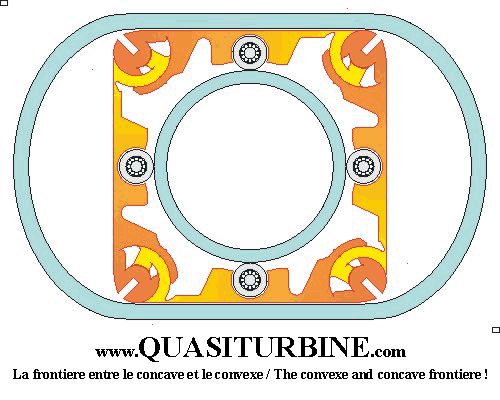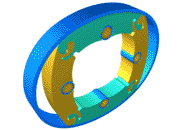Atmospheric pressure is the
relatively weak force filling compressor intake.
Slow sine-wave crankshaft movement wastes precious intake time.
Quasiturbine allows to better shape the intake vacuum volume pulse!
Quasiturbine Compressors
The Ratio: Flow to Compressor Volume and Weight
Why is the Quasiturbine compressor more compact? Considerer the
frontier case of the perfect skating rink Quasiturbine design:

The flow correspond to 8 chambers per revolution, which in this case is
exactly the rotor inner volume, for an exceptional flow (cfm) to machine
size and weight ratio, while still running at relatively low rpm. Model QT-SC are
slightly less performing in this regard, but
still quite unique.
Double Circuits
The Quasiturbine has 2 intakes and 2 exits
related to 2 quasi-distinct circuits. Each circuit can be used to compress
gas. The Quasiturbine is a positive displacement
compressor, and
does not make use of aero- or
hydro-dynamic flow consideration.

Quasiturbine SC (Without Carriage) Model
Reciprocal compressor reverses the flow while they compress, which is a
severe inertia, turbulent and heat generation limitation for high rpm. Because
the flow is peripheral and nearly unidirectional, the Quasiturbine is much less
sensitive to flow reversal, turbulence and heat generation, which improves it
efficiency. Check valves are generally suitable when used with compressible
fluid, but the Quasiturbine could as well work without it. Check valve is never required with
incompressible fluid like liquid.
Position of intake and exhaust ports can be slightly deported to account for
high rpm pressure lag time. The Quasiturbine does not produce
vibration.
The Quasiturbine could be made of plastic for compressor application.
The 2 circuits are of the same stage, and can not be mounted
in serial for a 2 stages effects, because they are of equal flow capacity.
However, they can both be used as a first stage into a buffer tank, and one
circuit could intake this buffer tank pressure say every 10 turns, in order to
get a double stages effect...
Improved Air Intake
Because of the crankshaft sine wave, the piston stays a long time at the
top, which prevents active early intake into the compressor. The Quasiturbine
(specially the model
AC -With carriages) allows to shape the intake vacuum pulse such as to
create a much faster depression in the chamber and to maintain it much
longer. This increases the intake capability from naturally aspirated air,
and allows for much faster rpm, and consequently better specific
compression performance.
Centrifugal Compressor
The Quasiturbine air intake can be done from the center through check
valves located within the blades. This way at high rpm, the Quasiturbine
compressor can cumulates both characteristics from the the positive
displacement compressor and the centrifugal compressor.
Compressor versus Air Motor
Both are in theory very alike. However, because of the flow inertia,
optimization of both mode may require a slightly different set of ports,
which can exist simultaneously.
Switching Air Motor-Compressor
Turning in reverse a Quasiturbine air motor will make it act as a
compressor. However, the direction of rotation can be keep the same, if
both exhausts are plug by a small check valve line taking the exhaust
pressure exit as the compressor output. Then, to prevent the air motor
intake two lines to be vacuumed, a check valve on them allowing-in
atmospheric air will suffice. This kind of switching motor-compressor mode
without changing the direction of rotation is useful for application
like windmill back up pneumatic air storage or vehicle breaking energy
recovery device.
Higher Efficiency
Notwithstanding other advantages (including the fact that QT has 2 compressor
circuits, one at the top and one at the bottom), the Quasiturbine compressor has a unique
property resulting from the sequential chambers geometry. In piston or Wankel
compressors, the residual compressed volume at top dead center which does not
make it through the check-valve, re-expand in the cylinder at the beginning of
the next intake process, destroying the early intake vacuum much needed for a
good chamber loading. In the Quasiturbine, early vacuum loading is not affected,
because the residual high pressure gas not making it through the check-valve is
made to flow into the following compression chamber at the end of the intake process
(and not forward into the other starting intake cycle), improving this way
substantially the pressure loading intake factor of the compressor. Furthermore,
the Quasiturbine compressor has the ability to run without any check-valve,
neither at intake or exit (some oscillating flow with compressible fluids).
This extra-dynamic-loading property is a major
compressor improvement, unachievable with piston compressors, and allows for the
Quasiturbine compressor to run at relatively higher rpm with optimum efficiency.
Consequently, not only the efficiency is improved, but the specific compression
capability which result in smaller and lighter compressors.
Similar argument also applies to the Quasiturbine used as a vacuum pump.
Application
As for any other compressor, pressure differential is limited by adiabatic
temperature and heat produced during compression, and the ability to remove this
heat from the compressor.
From the basic QT75SC of 75 cc per chamber engine bloc,
an air compressor prototype has been built making use of 2 parallel
compression circuits
of 300 cc per revolution each, for a total of about 15
cubic feet per minute at 1000 rpm (zero psi differential).
The Quasiturbine is very compact and light, still allows to compress large
volumes at low rpm with no vibration.
Refrigeration: Conventional pressure regulators cause all the gas from
the constant high pressure side to expand, and the gas pressure-kinetic energy
at the needle is converted into undesirable heat, thereby reducing the amount of
cold produced. The Quasiturbine rotary expander allows for individual chambers
to expand at a variable reduced pressure during expansion, and therefore reduces
the transformation of the gas' kinetic energy into destructive heat.
Furthermore, the Quasiturbine mechanically recuperates the gas' differential
pressure energy, which can be used to run more compressors and make more
refrigeration... for double the energy efficiency gain! This offers a great
enhancement to the thermodynamic cooling machine, especially in high power LNG -
Liquid Natural Gas liquefaction stations. Of course, this efficiency enhancement
is also available for more modest cooling systems and air conditioning
equipment. With Quasiturbine rotary expander, the efficiency of a gaseous only
(like dry air) system reaches almost the efficiency of a phase change
liquid-gaseous system, and sophisticated phase change chemical products often
environmentally unwelcome are not anymore needed.
ROTARY EXPANDER VALVE CALCULATION
Essentially, the extra cooling power will be equal to the extracted
power on the Quasiturbine expander shaft. More pressure power you remove mechanically, less
heat power there is in the gas flow to warms it up during relaxation! As an example, the
QT600SC expands 600 cc per chamber and 8 chambers per revolution. At 500 rpm,
this is 2,4 cubic meters per minute at intake, for up to 12 kW of output shaft
power under 60 psi differential. Every second, the Quasiturbine expander removes
(12 kW-sec) 12000 joules of thermal energy out of (2,4/60) 40 liters of 60 psi
intake gas (at the expander exit, this volume is about 5 x 40 = 200 liters, if
expanded to the atmospheric pressure). This is a removal of 300 joules
of heat per liter (or 300 watts out of a 1 liter/sec flow) at intake (60 psi); or 60 joules of heat per liter
(or 60 watts out of a 1 liter/sec flow) at exhaust
(atmospheric pressure). The cooling temperature gain depends of the gas specific
heat capacity. The exhaust gas cooling efficiency is
consequently enhanced (and could be even somewhat more, by using intake valve
cut-off cycle) compared to the use of a simple valve or pin hole, even if the
Quasiturbine expander shaft output power is simply dissipated and lost. However, this
shaft power can be re-used, possibly to recompress part of the gas, for a
double efficiency gain!
More Technical
Quasiturbine Theory Concept
Quasiturbine Rotary Expander
Quasiturbine Pump and Turbo-Pump
|